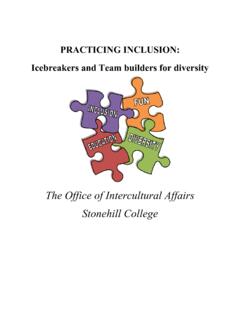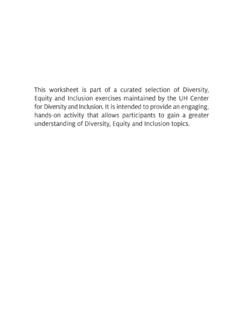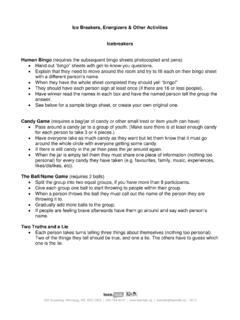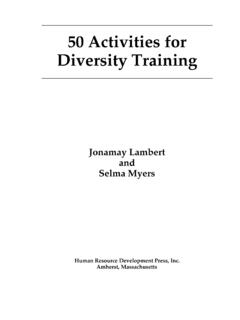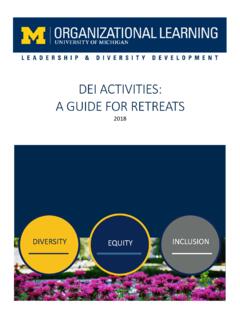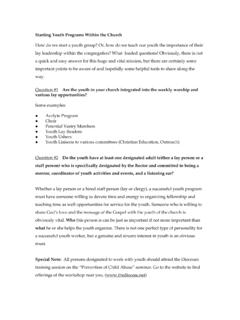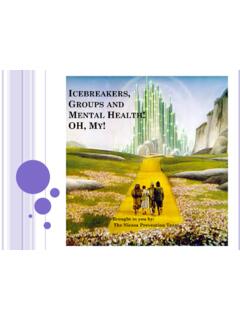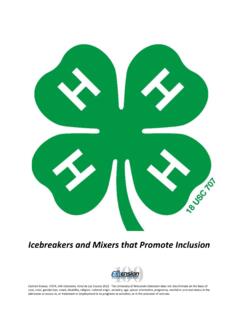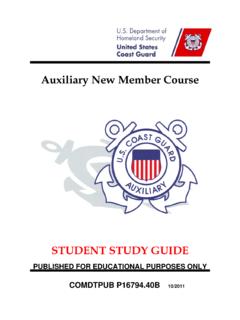Transcription of 50 Communications Activities
1 50 Communications Activities , icebreakers , and Exercises Peter R. Garber HRD Press, Inc. Amherst Massachusetts Copyright 2008, Peter R. Garber The materials that appear in this book, other than those quoted from prior sources, may be reproduced for educational/training Activities . There is no requirement to obtain special permission for such uses. We do, however, ask that the following statement appear on all reproductions. Reproduced from 50 Communications Activities , icebreakers , and Exercises, by Peter R. Garber. Amherst, MA, HRD Press, 2008. This permission statement is limited to reproduction of materials for educational or training events. Systematic or large-scale reproduction or distribution or inclusion of items in publications for sale may be carried out only with prior written permission form the publisher.
2 Published by: HRD Press, Inc. 22 Amherst Road Amherst, MA 01002 1-800-822-2801 413-253-3488 413-253-3490 (fax) ISBN iii Contents Part I. Communications Principles 1. Communications Is an 3 2. Communicating Time .. 7 3. Communications Is the Key .. 11 4. I Know You Believe You Understand .. 15 5. Communications 19 6. Listening Dilemma .. 23 7. Interactive Listening 27 8. Listening Bad Habits.
3 31 9. Listening Questionnaire .. 35 10. Seven Levels of Listening .. 41 11. Silent Messages .. 45 12. The Three Levels of Communications .. 47 13. Nonverbal Listening Test .. 55 14. Laws of Remembering .. 59 15. Laws of Forgetting .. 65 16. Meaning of Words .. 69 17. Communications 73 18. Attention Spans .. 79 19. Meaning of 83 Part II. Communications icebreakers 20. Vanity Name 89 21. Repeating Introductions .. 91 22. Circle, Square, Triangle, or Z .. 93 23. Introducing Each Other .. 95 24. Fantasy Career.
4 97 25. Name that Participant .. 99 26. Story of Your Name .. 103 27. Nickname Game .. 105 28. Introduction Bingo .. 107 29. Card Match .. 111 Part III. Communications Exercises 30. Reading Test .. 125 31. The Longest Line .. 129 32. Color Block .. 133 33. Following Directions .. 135 50 Communications Activities , icebreakers , and Exercises iv 34. Train Story .. 139 35. Count the Ss .. 141 36. Communications 147 37. Repeat the 151 38. Quick Answers .. 153 39. Rephrasing Exercise .. 155 40. Wedding Story .. 161 41. Who Done It? .. 167 42. Picture Puzzle .. 173 43. Creative Fairy Tale .. 177 44. 183 45. The Shoe Store .. 189 46. Two Moose Sitting on a Log .. 195 47.
5 Communications 197 48. Oh .. 203 49. Word Games .. 207 50. Trading Cards .. 227 v Preface Communications plays such a big part in our lives today. It is hard to think of a single activity that we engage in that doesn t involve Communications in some way. In our busy world, we sometimes forget just how important Communications are to our success, relationships, and, ultimately, happi-ness in life. But, indeed, Communications does play a major role in achieving all of our goals. These 50 Communications Activities are designed to help participants become more aware and prepared to deal effectively with the many types of Communications challenges they face every day. Each activity is designed to help par-ticipants better understand some facet of com-munications and gain expertise in that communi-cations skill or competency.
6 These Activities will make participants think about Communications in new and different ways than they ever did before. They will also find these exercises not only useful but memorable as well. I hope you enjoy learning and presenting these Communications exercises as much as I have over the past three decades of using them to help people become better communicators. Each is time tested and ageless. Have fun presenting these Activities along with those you present them to for many years to come. Peter R. Garber Part I: Communications Principles 3 1. Communications Is an Art Description: This activity explains that Communications is much more of an art than a science. There is no one right or wrong way to communicate no set of absolute rules to be followed.
7 Time Guideline: 20 minutes Purpose: To emphasize to participants that each of us communicates in our own style and in ways most comfortable and effective for each of us. Like art, Communications can take on unlimited forms and variations, each unique to the person engaged in the Communications . Resources: Handout 1-A Presentation: 1. Present Handout 1-A to participants. 2. Ask participants if they agree or disagree with this statement and why. 3. Explain that Communications does have certain principles and procedures (see other Activities in Part I of this activity book). There are specific, sound principles and themes, but thousands of variations. 4. However, there is no right or wrong way to communicate effectively.
8 5. Everyone has their own Communications style, and there are thousands and thousands of variations to effective Communications . What is most important is that people communicate in a sincere and honest manner with one another, in a style in which they are most comfortable. Few if any people can communicate effectively in a manner or style that does not fit them personally or naturally. Debrief: Ask participants if they have ever tried to communicate in a manner or style that was not natural to them, and, if so, how difficult was it to do this effectively. 50 Communications Activities , icebreakers , and Exercises 4 Difficulty Rating: Low Variations: Before showing or sharing Handout 1-A, ask par-ticipants if they believe Communications is more an art or a science.
9 If you hear the response from participants that they think communica-tions is more of a science, ask them why they feel this way. Ask them what would define some-thing as a science. Expect to hear comments that use terms such as consistent, exacting, etc. Ask if they feel that Communications would really be defined in this way. 5 Handout1-A Communications is much more of an art than a science. 7 2. Communicating Time Description: The amount of time we spend communicating with others is presented in this activity. Time Guideline: 20 minutes Purpose: To highlight the great amount of time we actually spend communicating with others Resources: Handout 2-A Presentation: 1. Ask participants how much time they think they actually spend communicating with others.
10 2. Allow the group to provide their estimates. Write the estimates on a flipchart or piece of paper. 3. Present Handout 2-A. Emphasize the statistics presented in this handout: 70% of your total waking time is spent communicating in some manner. Of this time you spend communicat-ing, you spend approximately 16% reading, 9% writing, 30% talking, and 45% listening. 4. Ask participants if they are surprised by these estimates of the average time that people spend communicating, especially the 45% lis-tening statistic. 5. Point out that these percentages may vary from person to person. For example, some people may spend much more than 30% of their Communications time talking and much less time listening!


